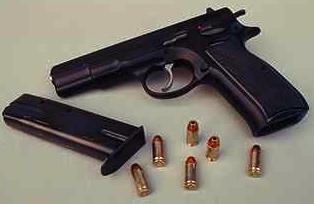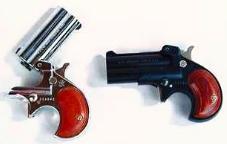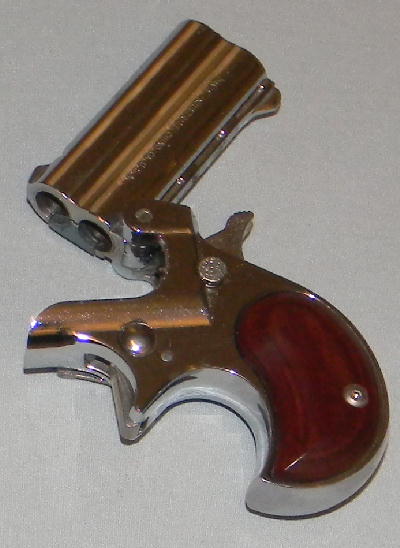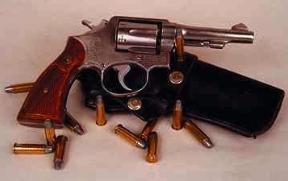

















How to Safely Verify That a Gun is Really Unloaded
Copyright © June 1, 2021 by Robert Wayne Atkins, P.E.
All Rights Reserved.
Introduction
 Shooting "accidents" happen with guns that are loaded.
Shooting "accidents" happen with guns that are loaded.
And many times the accident happens because someone believed that the gun was not loaded.
The purpose of this short article is to describe a safe way to verify that a firearm is "really" safe and that it does not contain any bullets.
Discussion
There are five basic categories of firearms as follows:
- Single shot rifles, shotguns, handguns, and derringers: Only one bullet can be loaded into the firearm and another bullet cannot be put into the firearm until the first bullet has been fired and the empty shell casing is removed from the firearm, or the first bullet is removed from the firearm.
- Double shot rifles, shotguns, and derringers: One or two bullets may be loaded into the firearm. When one bullet is fired the second bullet can then be fired. Some of these firearms have one trigger and some have two triggers, such as some double-barrel shotguns.
- Bolt action rifles, lever action rifles, pump shotguns, and revolvers: Several bullets may be loaded into the firearm based on the maximum capacity of the firearm. Only one bullet can be fired each time the trigger is pulled. Bolt action rifles, lever action rifles, and pump shotguns require that the empty shell casing be manually ejected and a live round inserted into the firing chamber by manipulating the bolt, lever, or pump. Some revolvers require that the hammer be pulled back to cock the revolver and then the trigger must be pulled to fire the bullet. But some revolvers will cock and fire a bullet each time the trigger is pulled.
- Semi-automatic rifles, shotguns, and pistols: Bullets are loaded into a separate detachable magazine or into a shell chamber below the barrel. The first bullet must be manually loaded into the firing chamber. Each time the trigger is pulled the bullet in the firing chamber is fired, the empty shell casing is automatically ejected, and the next live round is loaded into the firing chamber. The gun will continue to fire each time the trigger is pulled, if there are more bullets in the gun. When the gun is empty it must be reloaded.
- Fully-automatic rifles and pistols: Similar to semi-automatic weapons but when you pull the trigger one time the gun will keep firing until you release the pressure on the trigger, or when the gun runs out of bullets.
This article will review the first four types of firearms above because the author does not have any experience with fully-automatic weapons.
The following safety advice is the same for all firearms.
- Never point a firearm at yourself or another person. (The exception is if you intend to shoot the person, such as in self-defense or in a war.)
- Never put your finger on the trigger. (The exception is if you intend to shoot the firearm. Or if the firearm is cocked because you have finished cleaning it, and the firearm is unloaded, and you need to relieve the pressure on the firing mechanism.)
- When you put your finger on the trigger always make sure the firearm is pointed in a safe direction, or it is pointed in the direction that you want to shoot.
Single Shot Firearms
Rifle, Shotgun, Handgun, Derringer
 Keep your finger off the trigger.
Keep your finger off the trigger.
Point the firearm in a safe direction.
If the firearm has a safety, then engage the safety. However, if the safety will not allow you to open the firearm to verify that it is unloaded, then you may have to leave the safety disengaged.
Open the firearm and look into the rear end of the firing chamber. If there is a shell in the firing chamber then use the eject mechanism to eject the shell.
Close the firearm without putting a shell into the firing chamber.
The firearm is now unloaded.
Double Shot Firearms
Rifle (over/under), Shotgun (double barrel), Derringer (over/under)
 Keep your finger off the trigger. If the firearm has two triggers then keep your fingers off both triggers.
Keep your finger off the trigger. If the firearm has two triggers then keep your fingers off both triggers.
Point the firearm in a safe direction.
If the firearm has a safety, then engage the safety. However, if the safety will not allow you to open the firearm to verify that it is unloaded, then you may have to leave the safety disengaged.
Open the firearm and look into the rear end of both of the two firing chambers. If there is a shell in either or both firing chambers then use the eject mechanism to eject the shells.
Look into both firing chambers again and make sure that both firing chambers are empty.
Close the firearm without putting a shell into either firing chamber.
The firearm is now unloaded.
Manual Multiple Shot Firearms
Bolt Action Rifles, Lever Action Rifles, Pump Shotguns, Revolvers
Keep your finger off the trigger.
Point the firearm in a safe direction.
If the firearm has a safety, then engage the safety. However, if the safety will not allow you to open the firearm to verify that it is unloaded, then you may have to leave the safety disengaged.
 Bolt action rifles, lever action rifles, and pump shotguns:
Bolt action rifles, lever action rifles, and pump shotguns:
Live ammunition is stored inside the firearm in a chamber directly below the bolt, or the live ammunition is inside a long tube that is permanently mounted under the barrel.
If the firearm has an ammunition chamber that is permanently mounted under the barrel then it may be possible to remove the end of the chamber and its plunger, and allow the ammunition to slide out of the chamber. Then you can replace the end of the chamber with its plunger into the ammunition storage chamber and secure it in its normal position.
Assume the firearm is loaded. With the firearm pointed in a safe direction, operate the loading mechanism to eject a shell and to bring the next live shell into the firing chamber. Continue to operate the loading mechanism until a shell is not ejected from the firearm. Operate the loading mechanism again and verify a second time that a shell is not ejected from the firearm. Look into the rear end of the firing chamber where a shell is loaded and verify that the firing chamber is empty. Release the loading mechanism. Point the firearm in a safe direction, such as the ground a few feet away from yourself and other people. Pull the trigger to verify that the firearm is unloaded and to take the pressure off the firing mechanism.
The firearm is now unloaded.
Revolvers:
Release the cylinder mechanism so that the cylinder swings out from the revolver.
 Look into the loading end of the cylinder.
Look into the loading end of the cylinder.
If there are no shells in the cylinder then the revolver is unloaded.
If there are shells in the cylinder then push the unloading mechanism and it will push the shells out of the cylinder. Look into the cylinder and verify that the cylinder is unloaded.
Gently push the empty cylinder back into its normal position in the revolver. Do not swing the revolver in order to swing the cylinder back into position similar to what you see an actor do in a movie. This is harmful to the revolver and it should not be done. Treat your revolver with respect and it will last you for a very long time. If you mistreat your revolver then the cylinder may gradually get out of alignment with the firearm and you could injure yourself when you pull the trigger.
If the revolver is cocked, then put your thumb on the hammer and gradually allow the hammer to be lowered back against the revolver as you pull the trigger.
The revolver is now unloaded.
Semi-Automatic Multiple Shot Firearms
Rifles, Shotguns, Pistols
 Keep your finger off the trigger.
Keep your finger off the trigger.
Point the firearm in a safe direction.
If the firearm has a safety, then engage the safety. However, if the safety will not allow you to open the firearm to verify that it is unloaded, then you may have to leave the safety disengaged.
If the firearm has a removable magazine then eject the magazine from the firearm and set the magazine aside.
If the firearm has an ammunition chamber that is permanently mounted under the barrel then it may be possible to remove the end of the chamber and its plunger, and allow the ammunition to slide out of the chamber. Then you can replace the end of the chamber with its plunger into the ammunition storage chamber and secure it in its normal position.
Assume the firearm is loaded. With the firearm pointed in a safe direction, operate the loading mechanism to eject a shell and to bring the next live shell into the firing chamber. Continue to operate the loading mechanism until a shell is not ejected from the firearm. Operate the loading mechanism again and verify a second time that a shell is not ejected from the firearm. Look into the rear end of the firing chamber where a shell is loaded and verify that the firing chamber is empty. Release the loading mechanism. Point the firearm in a safe direction, such as the ground a few feet away from yourself and other people. Pull the trigger to verify that the firearm is unloaded and to take the pressure off the firing mechanism.
The firearm is now unloaded.
Conclusion
 Antique firearms and many 22 caliber rimfire firearms should not be "dry fired." Dry fired means cocking the firearm and pulling the trigger without a live round of ammunition in the firing chamber. To prevent damage to a 22 rimfire firearm it is possible to save a previously fired clean "empty" 22 caliber shell casing. Wipe any powder reside from the outside of the empty shell and use the end of a cotton swab to clean any loose gunpowder from inside the empty shell. The clean empty 22 caliber shell casing can now be manually placed into the firing chamber, and the trigger can be pulled, and the firing pin will strike the empty shell casing without firing a bullet and without damaging the firing pin. At some future date when you are ready to use your 22 rimfire firearm then you can remove the empty shell and begin using live ammunition.
Antique firearms and many 22 caliber rimfire firearms should not be "dry fired." Dry fired means cocking the firearm and pulling the trigger without a live round of ammunition in the firing chamber. To prevent damage to a 22 rimfire firearm it is possible to save a previously fired clean "empty" 22 caliber shell casing. Wipe any powder reside from the outside of the empty shell and use the end of a cotton swab to clean any loose gunpowder from inside the empty shell. The clean empty 22 caliber shell casing can now be manually placed into the firing chamber, and the trigger can be pulled, and the firing pin will strike the empty shell casing without firing a bullet and without damaging the firing pin. At some future date when you are ready to use your 22 rimfire firearm then you can remove the empty shell and begin using live ammunition.
You will not need an empty shell for a 22 rimfire revolver. You can lower the hammer on an empty 22 rimfire revolver by putting your thumb on the hammer and gently lowering the hammer when you pull the trigger.
 Important: Occasionally a live round of ammunition may get caught inside a firearm when you eject the magazine. When you operate the loading mechanism and look into the firing chamber the firing chamber will be empty. But when you release the loading mechanism it will push the live round of ammunition into the firing chamber. If you will take the time to operate the loading mechanism again then it will eject the live round and you will once again see an empty firing chamber. This rarely happens but it only has to happen once to ruin your life. Therefore please operate the loading mechanism a second time after you have verified that the firearm is empty the first time. This simple extra step may save your life or the life of another person.
Important: Occasionally a live round of ammunition may get caught inside a firearm when you eject the magazine. When you operate the loading mechanism and look into the firing chamber the firing chamber will be empty. But when you release the loading mechanism it will push the live round of ammunition into the firing chamber. If you will take the time to operate the loading mechanism again then it will eject the live round and you will once again see an empty firing chamber. This rarely happens but it only has to happen once to ruin your life. Therefore please operate the loading mechanism a second time after you have verified that the firearm is empty the first time. This simple extra step may save your life or the life of another person.
Always remember to begin by removing the magazine even if you know the magazine is empty. Please do not assume that the firearm is empty until after you have operated the loading mechanism two times and the firearm does not eject a shell either time. Then look into the read end of the firing chamber and verify that it is empty. Then look down into the magazine area and verify that the magazine area is completely empty and that there are no bullets (or a magazine) in the magazine area.
Respectfully,
Grandpappy.
Grandpappy's e-mail address is: RobertWayneAtkins@hotmail.com






































 Shooting "accidents" happen with guns that are loaded.
Shooting "accidents" happen with guns that are loaded. Keep your finger off the trigger.
Keep your finger off the trigger. Keep your finger off the trigger. If the firearm has two triggers then keep your fingers off both triggers.
Keep your finger off the trigger. If the firearm has two triggers then keep your fingers off both triggers. Bolt action rifles, lever action rifles, and pump shotguns:
Bolt action rifles, lever action rifles, and pump shotguns: Look into the loading end of the cylinder.
Look into the loading end of the cylinder. Keep your finger off the trigger.
Keep your finger off the trigger. Antique firearms and many 22 caliber rimfire firearms should not be "dry fired." Dry fired means cocking the firearm and pulling the trigger without a live round of ammunition in the firing chamber. To prevent damage to a 22 rimfire firearm it is possible to save a previously fired clean "empty" 22 caliber shell casing. Wipe any powder reside from the outside of the empty shell and use the end of a cotton swab to clean any loose gunpowder from inside the empty shell. The clean empty 22 caliber shell casing can now be manually placed into the firing chamber, and the trigger can be pulled, and the firing pin will strike the empty shell casing without firing a bullet and without damaging the firing pin. At some future date when you are ready to use your 22 rimfire firearm then you can remove the empty shell and begin using live ammunition.
Antique firearms and many 22 caliber rimfire firearms should not be "dry fired." Dry fired means cocking the firearm and pulling the trigger without a live round of ammunition in the firing chamber. To prevent damage to a 22 rimfire firearm it is possible to save a previously fired clean "empty" 22 caliber shell casing. Wipe any powder reside from the outside of the empty shell and use the end of a cotton swab to clean any loose gunpowder from inside the empty shell. The clean empty 22 caliber shell casing can now be manually placed into the firing chamber, and the trigger can be pulled, and the firing pin will strike the empty shell casing without firing a bullet and without damaging the firing pin. At some future date when you are ready to use your 22 rimfire firearm then you can remove the empty shell and begin using live ammunition. Important: Occasionally a live round of ammunition may get caught inside a firearm when you eject the magazine. When you operate the loading mechanism and look into the firing chamber the firing chamber will be empty. But when you release the loading mechanism it will push the live round of ammunition into the firing chamber. If you will take the time to operate the loading mechanism again then it will eject the live round and you will once again see an empty firing chamber. This rarely happens but it only has to happen once to ruin your life. Therefore please operate the loading mechanism a second time after you have verified that the firearm is empty the first time. This simple extra step may save your life or the life of another person.
Important: Occasionally a live round of ammunition may get caught inside a firearm when you eject the magazine. When you operate the loading mechanism and look into the firing chamber the firing chamber will be empty. But when you release the loading mechanism it will push the live round of ammunition into the firing chamber. If you will take the time to operate the loading mechanism again then it will eject the live round and you will once again see an empty firing chamber. This rarely happens but it only has to happen once to ruin your life. Therefore please operate the loading mechanism a second time after you have verified that the firearm is empty the first time. This simple extra step may save your life or the life of another person.
